When Excluded Realities Become Phantoms
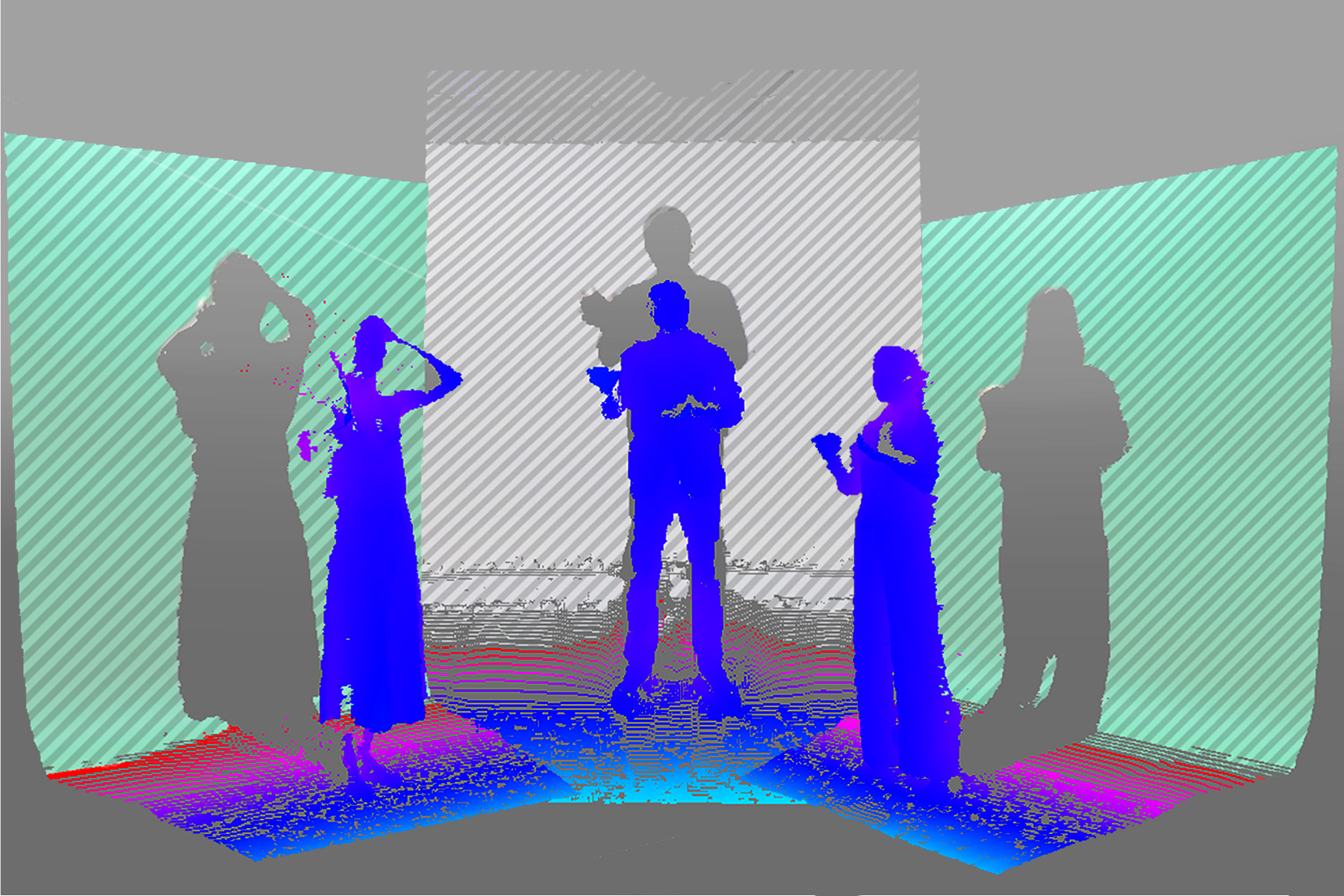
✉ ! "당신의 경험을 공유해주세요."
낯선 여행지에 도착했습니다. 가장 먼저 무엇을 하시겠습니까? 디지털 지도 앱을 열고 리뷰를 탐색하며, 길을 찾고 다음 일정을 계획할 것입니다. 지도 앱의 끝없이 이어지는 리뷰와 데이터는 우리에게 익숙한 길잡이처럼 보입니다. 하지만, 문득 이런 궁금증이 떠오릅니다. 이 많은 리뷰는 누가, 어떤 이유로 작성하는 걸까? 지도에 기록되지 못한 경험과 감각들은 어디로 사라질까? 우리는 다양한 의문과 함께 지도 플랫폼 알고리즘과 게이미피케이션에 의해 배제된 현실을 추적하고, 보이지 않는 경험들을 수집해 새로운 이야기로 재구성합니다.
✉ ! "Share your experience"
You have arrived at an unfamiliar destination. What is the first thing you do? You open your digital map app, browse reviews, find your way, and plan your next itinerary. The endless stream of reviews and data in the digital map seems like a familiar guide. But a question arises: Who is writing all these reviews, and for what reason? Where do the experiences and sensations that failed to be recorded on the map disappear to? Driven by various questions, we track the reality excluded by map platform algorithms and gamification, collecting these invisible experiences to construct a new narrative.
현대인들의 필수 앱: 지도 플랫폼
현대인들에게 디지털 지도는 없어서는 안 될 필수 요소이다. 실시간 교통정보, 목적지까지의 소요시간, 음식점 및 편의시설 찾기, 숙박 예약 등 단순한 길 찾기를 넘어 다양한 산업 군의 서비스를 제공한다. 지도 플랫폼은 스트리트 뷰(street view)와 리뷰를 통해 특정 장소를 가지 않아도 그곳의 경험과 정보를 습득할 수 있게 하며, 현실보다도 더 생경한 현실감을 위해 가상세계를 활용한 새로운 경험을 제안한다. 이미지만으로 만들어진 세계. 현실을 비물질적 가상세계로 재현한 구글 지도는 현실감을 극대화하기 위해“Google Cloud Immersive Stream” 라는 기능을 발표하며, 2차원의 이미지로만 접했던 장소를 360도로 돌려보고, 방문 예정일의 날씨와 시간까지 시뮬레이션할 수 있는 기술을 도입한다.
지도가 실시간 현실이라는 전제와 함께, 지도는 마치 개인비서처럼, 버려지는 시간을 최소화할 수 있도록 돕는다. 어떤 길로 가야 할지, 무엇을 먹을지, 근처에 쇼핑센터는 없는지, 또는 여행 중 어떤 숙소를 예약해야 할지를 판단할 때, 디지털 지도는 이용자들이 남긴 방대한 데이터를 바탕으로 최적의 선택지를 제안한다. 디지털 지도 유저는 목적지 주변이 리뷰를 살펴보며, 다른 사용자들의 경험을 통해 특정 공간에 대한 인상을 형성하고 선택을 내린다.
여기서 흥미로운 점은 리뷰라는 정보 생산 행위가 단순한 참고용 데이터를 넘어선다는 것이다. 인터뷰에 따르면, 리뷰어들은 자신의 글이 다른 사용자에게 도움이 될 수 있다는 점에서 만족감을 느끼고, 이러한 정동적 동기가 지속적인 활동을 가능케 한다고 이야기한다. 그러나 단순히 도움을 주기 위한 목적 외에도, 많은 리뷰어가 자신의 기록을 남기고 이를 통해 개인의 경험을 아카이브 하려는 심리적 동기를 언급했다. 특히 “리뷰를 통해 나만의 기억을 디지털화한다”는 점에서 리뷰 작성은 개인적 기록과 플랫폼 상호작용 사이의 접점으로 작용한다.
자신의 경험을 리뷰로 업로드하는 과정은 어떻게 진행될까. 사용자는 플랫폼이 설정한 규칙과 알고리즘에 맞춰 자신의 경험을 텍스트와 이미지로 변환하며, 이를 통해 플랫폼과 긴밀하게 연결된다. 이는 리뷰어들이 인터뷰에서 강조한 “가이드라인 체화”와 같은 개념으로 확장된다. 인터뷰에서 들을 수 있었던 “이제는 별도의 가이드를 참고하지 않아도 플랫폼에 적합한 데이터를 자연스럽게 생성할 수 있다”라는 표현을 통해, 플랫폼이 사용자의 경험을 점점 정형화하고 있음을 발견한다.
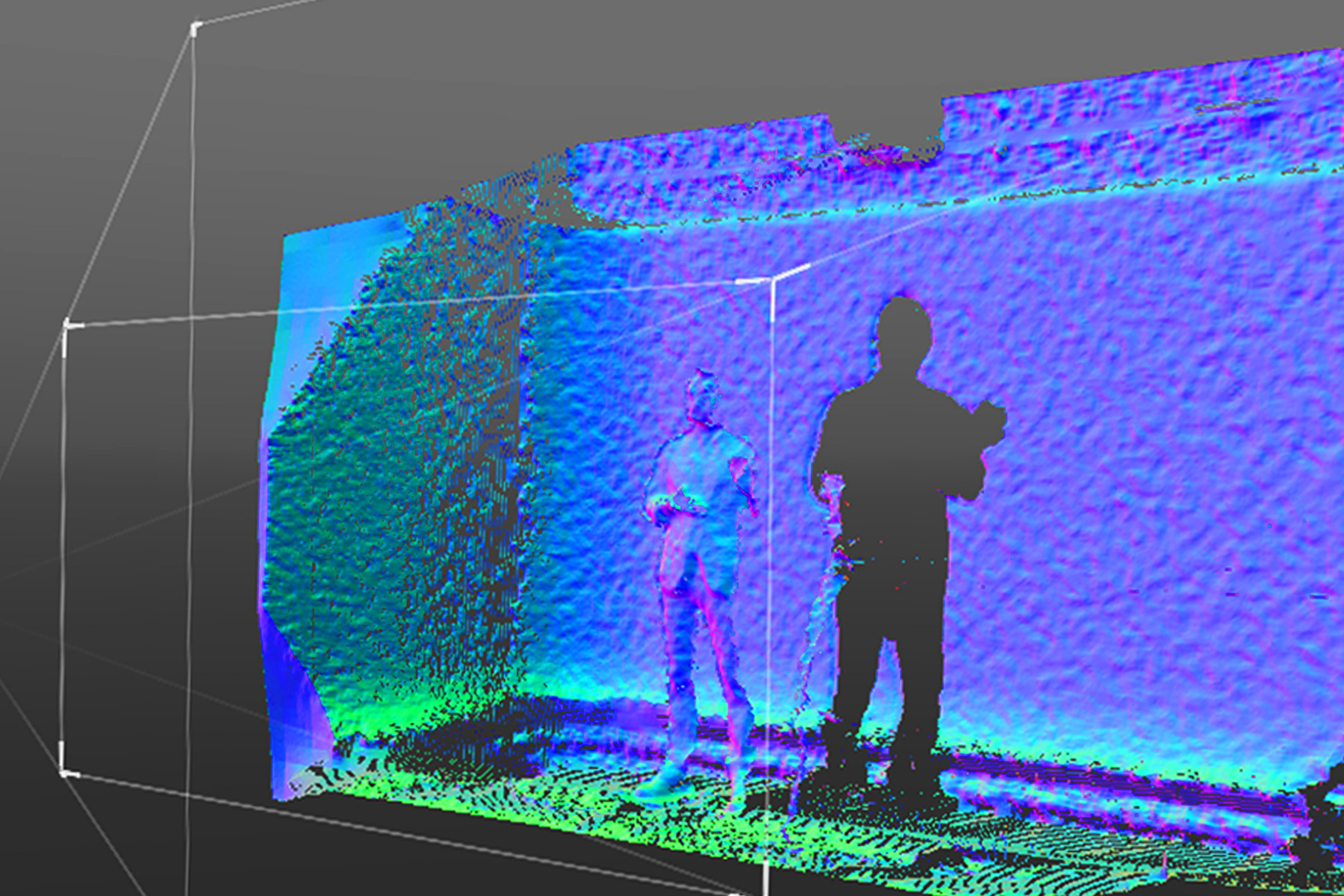
[Image Caption] The interview with the Local Guide was filmed using a depth camera to collect gestural data. The uncollected spatial data remained behind the Local Guide's wall, like a shadow.
Data and Review System: Share Your Experience
과거부터 현재까지 우리는 미지의 공간으로 끊임없이 이동하며 적합한 장소를 찾아내었다. 호기심과 함께 더 나은 환경을 찾아 이동의 이동을 거듭한다. 기술 사회로 접어들면서 이러한 이동과 탐색의 경험은 데이터로 기록되기 시작했고, GPS 기술을 토대로 새로운 경험을 만들어내는 플랫폼 서비스들이 등장한다. 2005년, Yelp와 같은 초기 리뷰 플랫폼이 등장하며 사용자가 자신의 경험을 텍스트로 기록하고 공유하는 문화가 시작되었다. 2013년, Google의 City Expert 프로그램이 잇달아 출시되며 리뷰 작성자들은 소규모 커뮤니티 안에서 양질의 데이터를 생산하도록 장려되었다. 리뷰 콘텐츠가 여행 산업, 지역 경제 등에 활용 가능성이 커지자 구글은 City Expert를 전 세계 유저가 활동할 수 있는 ‘지역 가이드’라는 서비스로 확장 개편하였다. 이제 디지털 지도 유저는 자신의 경험을 자유롭게 공유할 수 있으며, 아직 지도에 기록되지 않은 새로운 장소들을 찾아 등록할 수도 있다. 지도는 유저들의 참여를 독려하고 커뮤니티의 규모를 확대하기 위해 플랫폼 내에 ‘게이미피케이션’을 적용한다.
리뷰 작성, 사진 업로드, 동영상 게시와 같은 활동에 점수가 부여되며, 누적된 점수에 따라 사용자 레벨이 올라간다. 이러한 레벨 시스템은 사용자가 지속적으로 참여하도록 유도하는 강력한 동기로 작용한다. 레벨 6 이상의 높은 등급을 달성하기 위해서는 반복적으로 사진을 올리고 리뷰를 작성하는 등 플랫폼이 설정한 태스크를 충족해야 한다. 레벨이 올라갈수록 화려한 별 모양의 명예 뱃지 아이콘이 부여되며, 사용자는 이를 통해 자신의 기여를 가시화하고 다른 사용자로부터 신뢰를 얻는다. 이러한 시스템은 유저들 사이에서 강한 동기 부여를 창출하며, 목표 레벨 달성을 위한 팁을 서로 공유하거나 이를 축하하는 등 커뮤니티를 형성하게 한다.
유저들은 디지털 지도에 포함되지 않은 현실의 장소를 탐험하고, 정보를 기록하며, 새로운 공간을 발견하고 안내하도록 자발적으로 유도된다. 이러한 과정에서 사용자는 플랫폼의 데이터를 풍부하게 만드는 동시에 스스로를 지역 가이드라는 역할 속에 자리 잡게 한다.
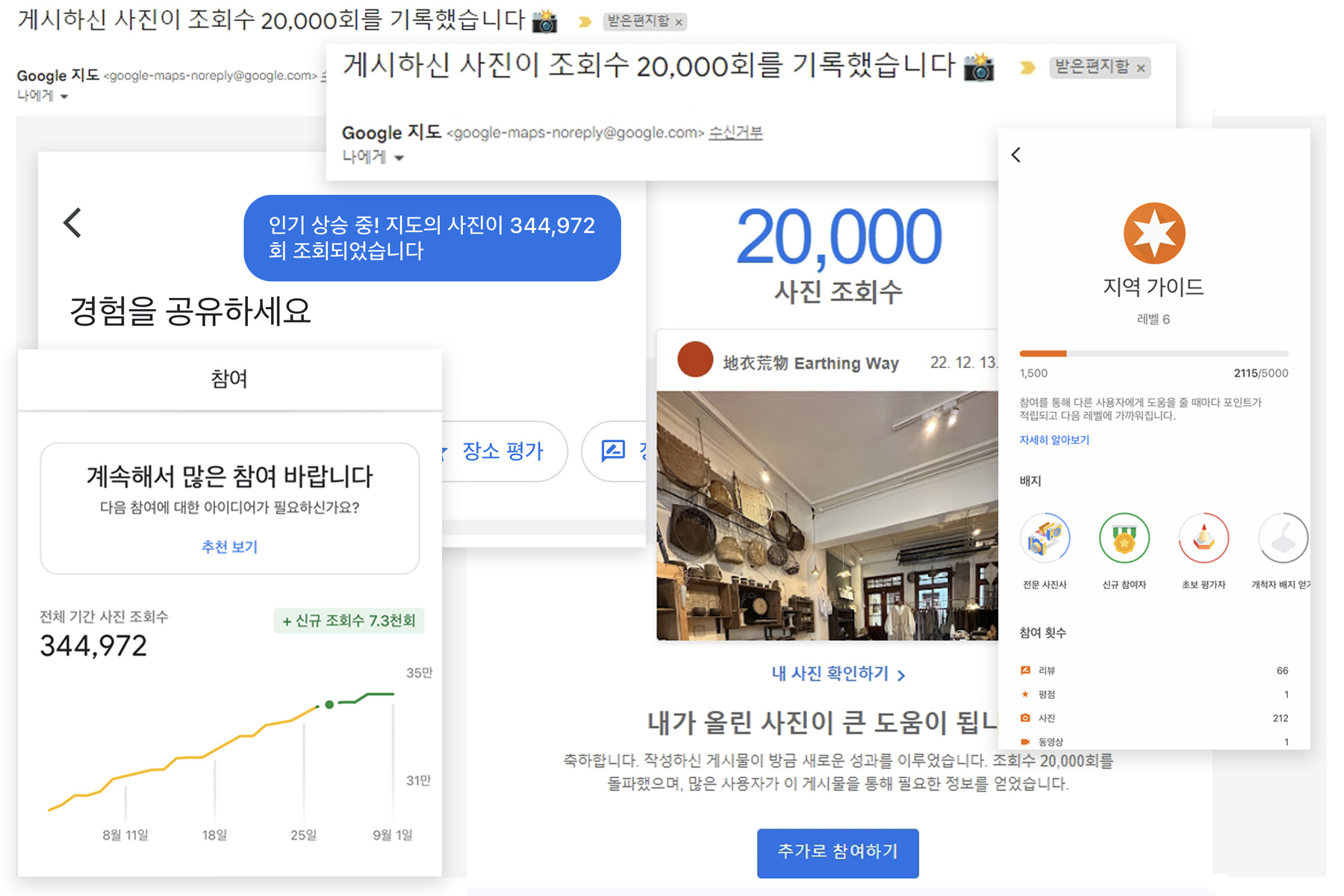
[Image Caption] Emails and push alarms requesting active participation, and the Level 6 badge.
그러나 게이미피케이션은 플랫폼의 가이드라인과 알고리즘에 의해 사용자 경험이 정형화되는 문제도 동반한다. 한 인터뷰에서는 "사진의 퀄리티보다는 장소를 명확히 식별할 수 있는 전면 사진이 선호된다"는 점과 "플랫폼 알고리즘이 특정 기준을 충족하지 못한 리뷰를 반영하지 않거나 리뷰의 업로드 시간이 평소보다 지연된다”는 사례가 언급되었다. 이는 플랫폼이 데이터를 선별하고 정제하는 방식에서 개인적 감각과 독창성을 소외시키는 경향을 보여준다.
디지털 지도의 게이미피케이션은 사용자들이 자발적으로 플랫폼의 데이터 생산자가 되도록 유도하며, 이를 통해 플랫폼은 방대한 양의 데이터를 축적하고 이를 기반으로 한 서비스를 더욱 강화한다. 이 과정에서 발생하는 데이터의 정형화와 사용자 경험의 왜곡, 그리고 알고리즘의 불투명성은 디지털 시대의 새로운 논의 지점을 제시한다.
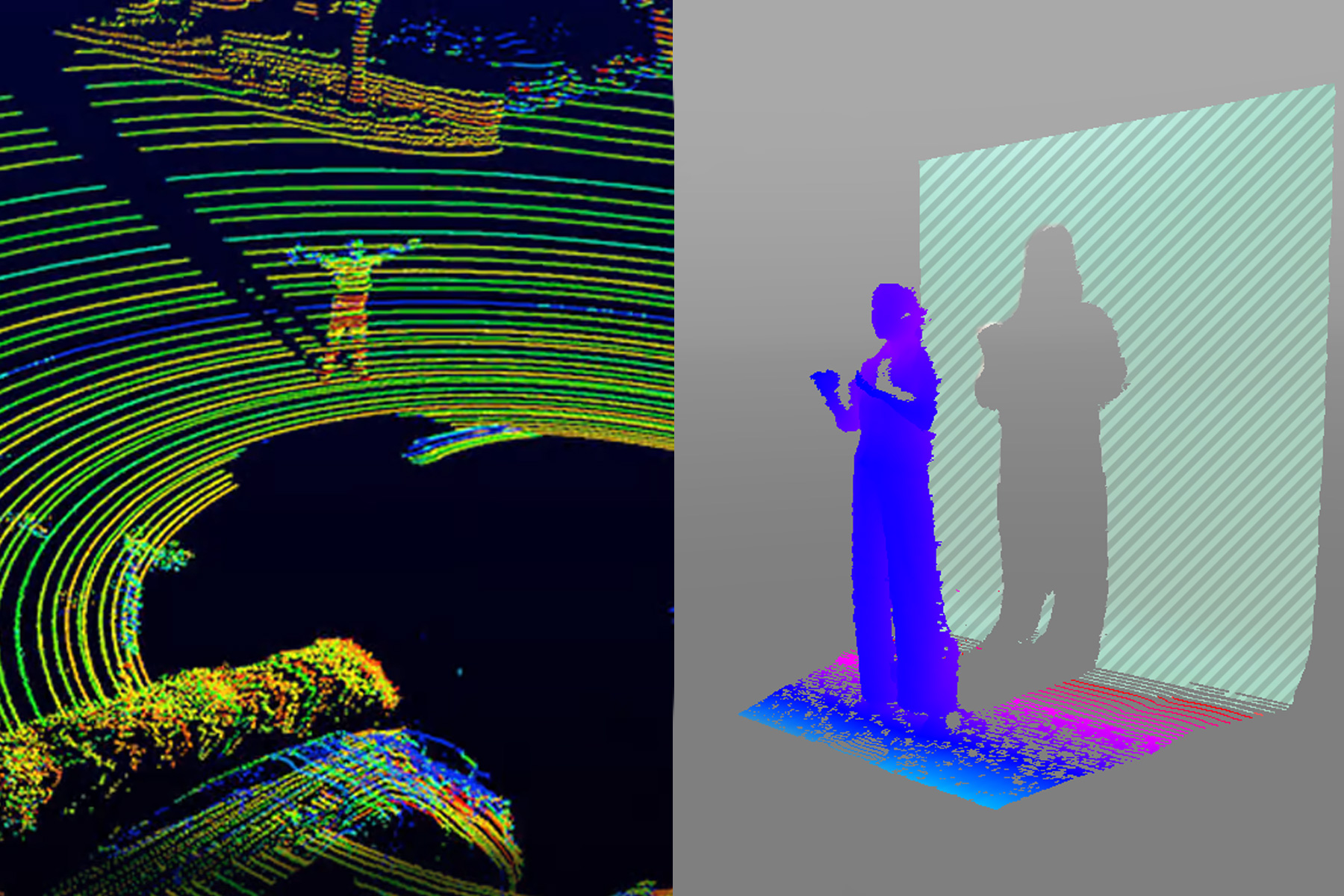
[Image Caption] The principle of 3D scanning technology used in industry is intentionally misused and exposed in the work's staging. If an obstacle is placed in front of a landscape being digitized by a 3D scan, data loss occurs in that area, making the data-less parts appear like shadows. The work actively utilizes this image to represent the digital map reviewers as lost data.
The Essential App: Map Platforms
For modern people, digital maps are an indispensable necessity. Beyond simple navigation, they offer services across various industries, including real-time traffic information, estimated time of arrival, finding restaurants and facilities, and booking accommodation. Map platforms enable us to acquire experiences and information about a specific location without physically visiting it, through Street View and reviews. They even propose new experiences using a virtual world to achieve a sense of reality more vivid than reality itself. The world is constructed purely of images. Google Maps, which reproduces reality into an immaterial virtual world, has announced a feature called “Google Cloud Immersive Stream” to maximize realism, introducing technology that allows users to rotate a place seen only in 2D images by 360 degrees and even simulate the weather and time of the planned visit.
Based on the premise that the map is a real-time reality, it acts like a personal assistant, helping to minimize wasted time. When deciding which route to take, what to eat, whether there is a nearby shopping center, or what accommodation to book during a trip, the digital map suggests the optimal choices based on the vast data left by users. Digital map users look at reviews around a destination, forming an impression of a specific space and making a choice through the experiences of others.
The interesting point here is that the act of producing review information goes beyond mere reference data. According to interviews, reviewers feel satisfied that their writing can help other users, and this affective motivation enables continuous activity. However, in addition to the purpose of helping others, many reviewers cited a psychological motive to leave their own record and archive personal experiences. Specifically, the act of writing a review serves as an intersection between personal record and platform interaction, especially in terms of "digitizing one's own memories through reviews."
How does the process of uploading one's experience as a review proceed? Users convert their experience into text and images according to the rules and algorithms set by the platform, establishing a close connection with it. This extends to the concept of "embodiment of guidelines," emphasized by reviewers in the interviews. Expressions such as "Now, even without referring to a separate guide, I can naturally generate data suitable for the platform" suggest that the platform is increasingly standardizing users' experiences.

[Image Caption] The interview with the Local Guide was filmed using a depth camera to collect gestural data. The uncollected spatial data remained behind the Local Guide's wall, like a shadow.
Data and Review System: Share Your Experience
From the past to the present, we have continuously moved to unknown places to find suitable locations. Driven by curiosity, we repeat moves in search of better environments. As we entered the technological society, these experiences of movement and exploration began to be recorded as data, and platform services emerged that create new experiences based on GPS technology. In 2005, early review platforms like Yelp appeared, initiating a culture where users record and share their experiences in text. In 2013, Google's City Expert program was successively launched, encouraging reviewers to produce high-quality data within small communities. As the potential for review content in the travel industry and local economy grew, Google expanded and reorganized City Expert into a "Local Guides" service where users worldwide could participate. Now, digital map users can freely share their experiences and even find and register new places not yet recorded on the map. The map encourages user participation and expands the size of the community by applying 'gamification' within the platform.
Activities such as writing reviews, uploading photos, and posting videos are assigned points, and the user's level increases with the accumulated score. This level system serves as a powerful incentive for users to participate continuously. To achieve a high rank of Level 6 or above, users must fulfill platform-set tasks, such as repeatedly uploading photos and writing reviews. As the level increases, a glamorous star-shaped badge icon is granted, through which users visualize their contributions and gain trust from other users. This system creates strong motivation among users, leading to the formation of a community where they share tips for reaching target levels and celebrate each other's achievements.
Users are voluntarily induced to explore real-world places not included in the digital map, record information, and discover and guide new spaces. In this process, the user positions themselves as a Local Guide, a platform service user who simultaneously enriches the platform's data.

[Image Caption] Emails and push alarms requesting active participation, and the Level 6 badge.
Gamification, however, is accompanied by the problem of user experiences being standardized by the platform's guidelines and algorithms. One interviewee mentioned that "front-facing photos that clearly identify the place are preferred over photo quality," and that "the platform algorithm either fails to reflect reviews that do not meet certain criteria or delays the upload time of reviews." This indicates a tendency for the platform to alienate personal sensibility and originality in the way it filters and refines data.
The gamification of digital maps encourages users to voluntarily become data producers for the platform, through which the platform accumulates vast amounts of data and further reinforces the services based on it. The standardization of data, the distortion of user experience, and the opacity of the algorithm that occur during this process present a new point of discussion in the digital age.

[Image Caption] The principle of 3D scanning technology used in industry is intentionally misused and exposed in the work's staging. If an obstacle is placed in front of a landscape being digitized by a 3D scan, data loss occurs in that area, making the data-less parts appear like shadows. The work actively utilizes this image to represent the digital map reviewers as lost data.
탈락한 현실은 유령이 된다
1. 지도가 가상성을 지우는 방법
지도는 물질적 부재를 메우기 위해 물리적 증거를 가상 공간으로 가져오려 시도한다. 그 공간에 방문했었다는 위치 데이터(GPS) 인증. 이용자의 위치와 연결되는 텍스트와 이미지, 그리고 동영상 리뷰까지. 지도 속 모든 정보가 ‘지금’ 일어나고 있다는 전제를 증명하기 위해 현실의 증거들을 끊임없이 불러들인다. R수집, 가공, 선별된 데이터들로 지도 위에 현실이 새롭게 구성된다. 리뷰와 GPS 데이터를 기반으로 특정 장소가 강조되고, 이를 통해 공간의 정체성이 형성된다. 예컨대, 많은 리뷰가 남겨진 장소는 그렇지 않은 장소에 비해 더 주목받으며, 이는 여행객이나 지역 주민의 소비 선택에 직접적인 영향을 미친다. 이처럼 디지털 지도는 물리적 현실 위에 새로운 경제적, 사회적 현실을 덧씌운다.
하지만 “잘못된 영업시간 정보를 수정하려 했지만 플랫폼에 반영되지 않았다”는 사례와 “알 수 없는 알고리즘에 의해 높은 레벨의 계정이 비활성화된 경험”이 지역 가이드 커뮤니티에 공유되었다. 알고리즘에 의해 사용자가 경험한 현실은 지도 위에서 사라질 수도 있는 것이다. 또한, 특정 데이터를 선별적으로 강조하여 사용자 경험을 재구성한다는 인터뷰도 들을 수 있었다. 리뷰가 많은 계정일수록 노출 우선순위가 높아지며, 이는 빈익빈 부익부 현상을 가속화한다. 한 인터뷰 참여자는 "500개 이상의 리뷰를 작성한 자신의 리뷰가 항상 상위에 노출된다"고 언급하며, 알고리즘이 특정 유저의 경험을 더 많이 반영하도록 설계되었다고 지적했다.
2. 환상을 유지하기 위한 규칙
환상의 실재화 (완벽한 가상)을 위해서는 플랫폼이 설정한 “게임의 규칙”이 지켜져야 한다. 사용자는 리뷰를 작성하며 플랫폼의 가이드라인을 충족시켜야 하고, 알고리즘은 이를 필터링해 적합한 데이터만 남긴다. 인터뷰에 따르면, 가이드라인에 어긋나는 리뷰는 삭제되며, 리뷰어들은 커뮤니티를 통해 삭제 원인을 추론하고 정보를 공유한다. 한번 걸러진 리뷰는 다시 복원되지 않기 때문에, 리뷰어들은 무통보 삭제되는 리뷰의 원인을 스스로 찾을 수밖에 없다.
3. 정형화되는 커뮤니케이션
가상(환상)으로부터 떨어지지 않기 위해, 게임에 계속 참여하기 위해, 그리고 무엇보다 디지털 지도에서 탈락하지 않기 위해 노력하는 유저들과 이를 독려하기 위한 플랫폼의 게이미피케이션 방식은 디지털 지도 속 커뮤니케이션 방식의 정형화로 이어진다. 리뷰는 점점 다루기 쉬운 데이터로 압축되고, 흘러가는 시간, 맥락, 감각적 경험은 소거된다. 예컨대, 한 인터뷰 참여자는 "리뷰는 장소의 객관적 이미지와 반복적인 단어로 요약되며, 감정은 점수와 데이터로 대체 된다"고 언급했다. 이러한 정형화는 디지털 지도 속에서 개인의 경험을 하나의 데이터 포인트로 축소하며, 현실을 객관적이고 획일화된 이미지로 환원한다. 확고한 게임의 규칙 속에서 개인의 감정과 감각과 같은 유기적인 데이터는 기록되지 못하고 어디론가 흘러간다. 리뷰를 통해 우리는 어떤 경험을 공유하고 있을까?
4. 가상공간이 삼키는 정동
디지털 지도 플랫폼은 리뷰 속에 담긴 정동(감정과 생동감)을 경제적 재료로 가공하며, 가상 공간을 더욱 풍부하게 만드는 데 집중한다.유저가 조금이라도 더 플랫폼 내에 머물며 리뷰 콘텐츠를 생성해 낼 수 있도록, 지도는 정동을 프레임에 고정한다. 포인트를 얻고 더 높은 지역 가이드 레벨에 도달하기 위해, 그리고 블랙박스를 무사히 통과하기 위해 안전하다고 증명된 규칙에 따라 개인의 경험을 정제한다. 가장 많이 반복된 단어들이 선별되고, 리뷰 창 상단에 키워드 태그로 고정된다. 지역을 방문하려는 유저들은 원하는 태그를 통해 지체 없이 정보를 찾고 떠날 것이다.
투명해지는 플랫폼 노동의 실태가 더해지며, 동시대 다른 디지털 조립라인의 작업자들처럼, 디지털 지도 속 리뷰어들의 존재와 그들의 경험은 특정할 수 없는 수많은 데이터 중 하나, 유령이 된다. 플랫폼을 통해 다른 사용자들과 자신의 기억과 경험을 주고받는 형태의 연대보다, 프레임 밖으로 밀려나지 않기 위한 플랫폼과의 연대가 견고해진다. "개인적 경험의 공유"를 넘어 "플랫폼 속 생존"으로 변질된다. 현실을 재현하기 위해 데이터화된 경험과 감각은 점차 정형화되고, 그 과정에서 지도의 틀에 맞지 않는 감각과 정동은 소외된다. 이 배제된 경험들은 어디로 사라지는가? 지도 위에 남지 못한 데이터는 유령처럼 떠돌며, 현실과 가상의 경계 밖으로 밀려난다. 디지털 지도가 현실을 증명하려는 시도는 탈락한 현실의 유령화를 동반한다.
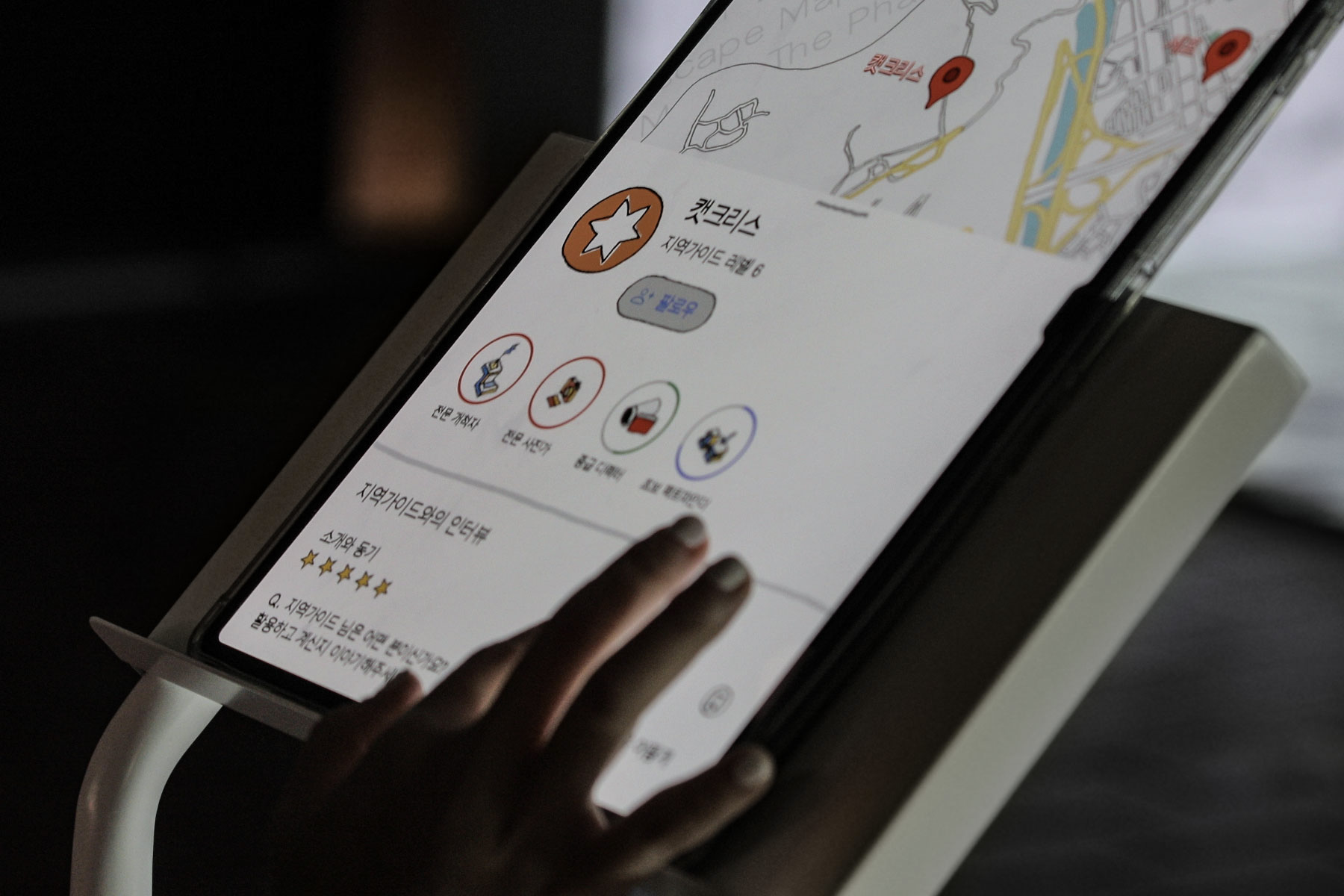
부재로부터 존재를 소환하기
1. 장소를 감각하기
장소의 경험하고 이해하는 과정은 단순히 눈에 보이는 정보에만 의존하지 않는다. 지리지형, 장소의 체감 규모, 장소를 이루고 있는 사람들, 공기의 흐름 등 데이터화되지 않는 순간적인 감각들이 장소의 정체성을 형성한다. 디지털 지도는 우리에게 어떤 경험을 했느냐 묻지만, 데이터로 전환된, 명확히 정의될 수 없는 감각적 요소들은 점차 배제된다.
플랫폼은 장소의 현재 상태를 업데이트하도록 유저를 독려하며, 가게의 문이 열려있는지, 가격과 혼잡도 등이 주요 업데이트 내용이 된다. 해외에서 한 칼럼니스트가 리뷰 조회수 1위를 기록한 지역 가이드와 진행했던 인터뷰 영상을 본 적이 있다. 어느 가게의 영업시간이 적혀있는 사진을 올리려던 지역 가이드가 영업시간 표기가 잘못되었음을 알고 수정해 올렸지만, AI 필터링에 의해 반영되지 않았던 사례가 언급되었다. 이 이야기는 개인적 감각과 경험이 “현재성을 증명하는 데이터”로 전환되지 못했을 때, 플랫폼이 이를 거부하는 방식을 보여준다.
“당신이 한 진짜 경험을 적어달라”는 리뷰 작성 규칙은 어디까지 적용되는 것일까. 과거와 현재, 그리고 미래를 연결하는 시간이 혼재된 데이터는 어떤 의미를 가질 수 있을까. 현재와 달랐던 과거의 경험을 묘사한 리뷰는 수용될 수 있을까. 개인의 기억은 플랫폼이 요구하는 데이터 형식으로 정제될 수 있는가.
2. 이야기의 순환
리뷰에 남겨진 개개인의 기억은 데이터 효용성을 기반으로 기억은 낱알처럼 쪼개지고 분류되며, 표면적 서술로 나열되기를 기다린다.
리뷰가 묘사하는 공간에 대해 이야기를 나누다가 어릴 적 동네에 대한 꿈에 대한 주제로 넘어간 적이 있다. 항상 꿈에 등장하는 장소는 동네의 길을 지도로 명확히 그릴 수도 없었던, 아주 어린 시절 살았던 공간이었다. 감각적 기억을 통한 공간. 장소의 재현은 순환되고, 상상되며, 또 다른 기억을 불러일으킨다. 기억 속 공간은 세워졌다가 다시 무너지고 다시 새로운 세계로 연결된다. 이야기가 이어진다.
타인의 이야기로부터 공간을 감각한다는 것에 대해 생각해본다. 데이터로 정형화되기 이전의 경험. 일시적이고 모호한 기억의 조각들로 감각을 회복하고 새로운 세계를 상상한다.
3. 탈락한 현실을 수집하기
우리는 지역 가이드와 직접 인터뷰를 진행하며, 리뷰에서 볼 수 없었던 몸짓, 말투, 감정 등의 비정형적 데이터를 수집했다. 리뷰 생태계에서 포함되지 못했던 요소들을 담아내려는 시도로, 작품 속에서 "로우 데이터"로서의 경험을 탐구하는 출발점이 되었다. 지도 플랫폼의 리뷰 활동을 통해 유저들이 자신의 감각과 경험을 디지털화해온 방식을 들여다보며, 그 과정에서 무엇이 배제되었고 무엇이 정형화되었는지 질문했다.
특히, 인터뷰는 플랫폼 사용자들이 자신도 모르게 디지털화에 적응하며 감각과 경험을 정제해 온 방식을 드러냈다. 리뷰 시스템이 요구하는 “현재성을 증명하는 데이터”에 맞춰 경험을 축약하면서, 무엇이 소외되고 있는지를 반추하게 했다. 이는 우리가 플랫폼의 틀에 맞춰 감각을 점점 정형화하는 동안, 배제된 경험과 감각이 플랫폼 바깥에서 어떤 가능성을 가지고 떠돌게 되는지를 탐구하는 작업이었다.
작품은 정형화되지 않은 데이터를 기반으로, 플랫폼의 틀 밖에서 새로운 이야기를 창조한다. 몸짓과 목소리, 감각적 기억은 플랫폼이 가시화하지 않는 세계를 복원하며, 새로운 공간과 시간성을 상상하도록 이끈다. 우리는 탈락한 현실의 유령들을 통해 무엇을 회복할 수 있을까?
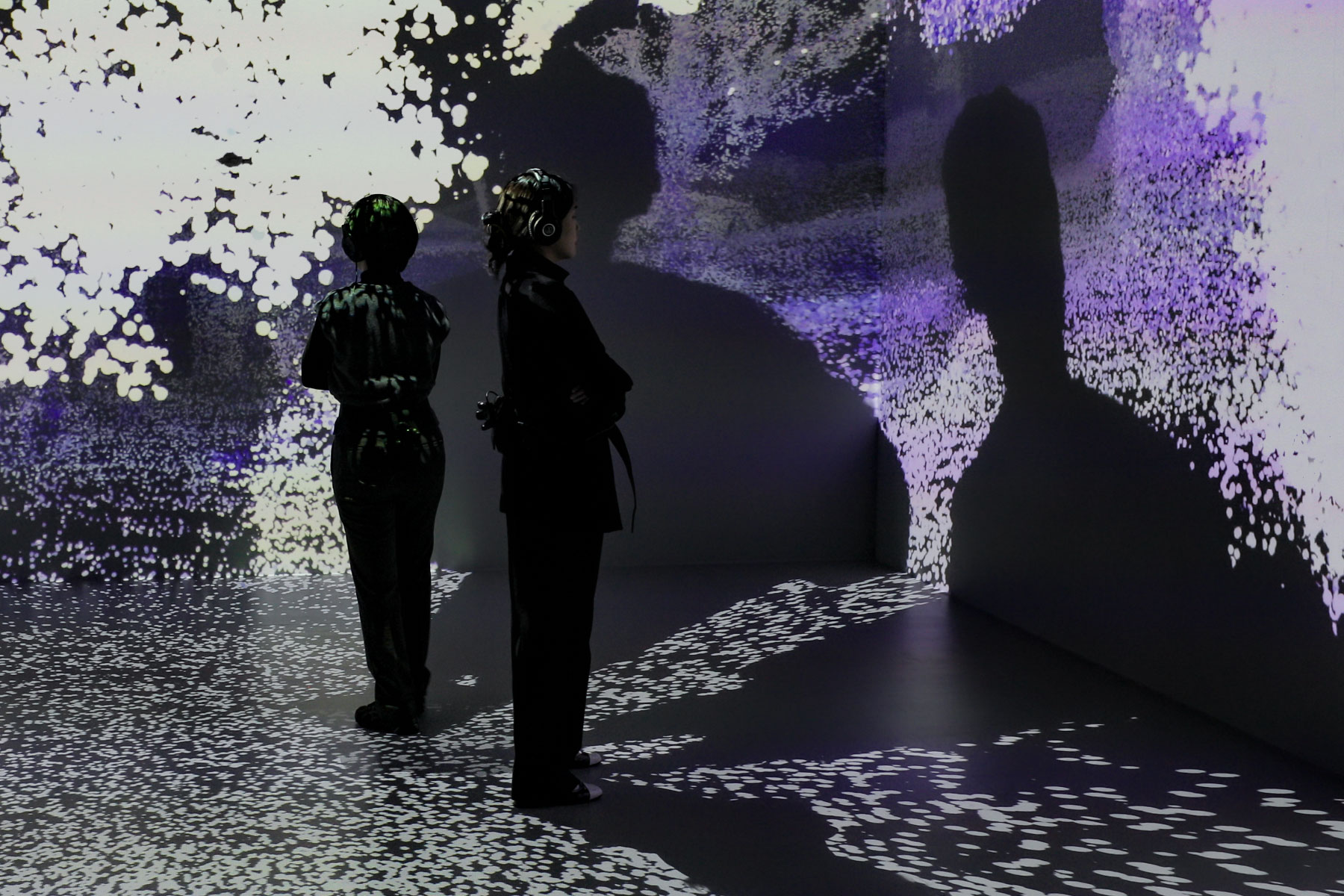
Excluded Realities Become Phantoms
1. How the Map Erases Virtuality
The map attempts to bring physical evidence into the virtual space to fill material absence. Location data (GPS) verification that a space was visited. Text, image, and video reviews linked to the user's location. The map constantly summons evidence from reality to prove the premise that all information within it is happening 'now.' Reality is newly constructed on the map with collected, processed, and selected data. Specific locations are emphasized based on reviews and GPS data, which forms the identity of the space. For instance, places with many reviews receive more attention than those without, directly influencing the consumption choices of travelers or local residents. In this way, the digital map overlays a new economic and social reality onto the physical reality..
However, examples such as "attempting to correct incorrect business hours information but failing to be reflected on the platform" and "the experience of a high-level account being deactivated by an unknown algorithm"have been shared in the Local Guides community. The reality experienced by the user can disappear on the map due to the algorithm. We also heard interviews mentioning that the platform selectively emphasizes certain data to reconstruct the user experience. Accounts with many reviews are prioritized for exposure, which accelerates the phenomenon of the rich getting richer and the poor getting poorer. One interviewee mentioned that "their reviews, having written over 500, are always exposed at the top," pointing out that the algorithm is designed to reflect the experiences of specific users more heavily.
2. The Rules to Maintain the Illusion
To realize the illusion (perfect virtuality), the "rules of the game" set by the platform must be followed. Users must satisfy the platform's guidelines when writing reviews, and the algorithm filters this to leave only the appropriate data. According to interviews, reviews that violate guidelines are deleted, and reviewers speculate on the cause of deletion and share information through the community. Since once-filtered reviews are never restored, reviewers are left to find the reasons for unannounced deletions themselves.
3. The Standardization of Communication
The users' efforts to avoid falling out of the virtual (illusion), to continue participating in the game, and above all, to avoid being excluded from the digital map, along with the platform's gamification to encourage this, lead to the standardization of communication within the digital map. Reviews are increasingly condensed into easily manageable data, and the flow of time, context, and sensory experiences are eliminated. For instance, one interviewee stated that "reviews are summarized by objective images and repetitive words of the place, and emotions are replaced by scores and data." This standardization reduces the individual's experience to a single data point within the digital map, converting reality into an objective and uniform image. Within the rigid rules of the game, organic data such as personal emotion and sensation are not recorded and flow away somewhere. What kind of experience are we sharing through reviews?
4.Affect Swallowed by the Virtual Space
The digital map platform focuses on using the affect (emotion and vitality) contained in reviews as an economic resource to further enrich the virtual space. The map fixes affect within its frame, to encourage users to stay on the platform and generate review content for as long as possible. Individuals refine their experiences according to rules proven safe to earn points, reach higher Local Guide levels, and pass safely through the black box. The most frequently repeated words are selected and fixed as keyword tags at the top of the review window. Users visiting the area will find the information they want without delay through the desired tags and move on.
Coupled with the reality of increasingly transparent platform labor, the existence and experiences of reviewers in the digital map, like workers on other contemporary digital assembly lines, become phantoms—one of countless data points that cannot be specified. The solidarity formed through exchanging memories and experiences with other users via the platform is less robust than the solidarity with the platform necessary for survival within the platform. It devolves from "sharing personal experience" to "survival within the platform." Experiences and sensations digitized to represent reality become increasingly standardized, and in the process, senses and affects that do not fit the map's frame are alienated. Where do these excluded experiences disappear to? Data that fails to remain on the map wanders like a phantom, pushed outside the boundary between reality and the virtual. The digital map's attempt to prove reality is accompanied by the phantomization of excluded reality.

Summoning Existence from Absence
1. Sensing the Place
The process of experiencing and understanding a place does not rely solely on visible information. Momentary sensations that are not digitized—such as geographical features, the felt scale of the place, the people who constitute the place, and the flow of air—form the identity of the place. The digital map asks us what experience we had, but sensory elements that are converted to data and cannot be clearly defined are gradually excluded.
The platform encourages users to update the current state of a place, with key updates including whether a store is open, its price range, and its congestion level. I once watched an interview with a Local Guide who ranked first in review views in a foreign country. They mentioned an instance where the Local Guide tried to upload a photo with the store's business hours, realized the displayed hours were incorrect, corrected them, and uploaded the corrected image, but it was not reflected due to AI filtering. This story shows how the platform rejects personal sensation and experience when it fails to be converted into "data that proves present-ness."
To what extent do the review-writing rules that state, "write down your real experience," apply? What meaning can data have when time is intermixed, connecting the past, present, and future? Can a review describing a past experience different from the present be accepted? Can personal memory be refined into the data format required by the platform?
2. The Circulation of Narrative
The individual memories left in reviews are fragmented and classified like grains based on their data utility, awaiting superficial narration.
While talking about the space described in a review, we once moved onto the topic of dreams about childhood neighborhoods. The place that always appeared in dreams was the space where I lived in very early childhood, whose streets could not be clearly drawn on a map. A space through sensory memory. The representation of the place circulates, is imagined, and evokes alternative memories. The space in memory is built up, then collapses again, and connects to a new world. The story continues.
I think about sensing a space through the stories of others. Experience before it is standardized into data. We recover sensation and imagine a new world through temporary and ambiguous fragments of memory.
3. Collecting Excluded Reality
We conducted direct interviews with Local Guides, collecting unstructured data such as gestures, tone of voice, and emotions that could not be seen in reviews. This attempt to capture elements that were excluded from the review ecosystem became the starting point for exploring experience as "raw data" within the work. We examined how users have digitized their senses and experiences through the map platform's review activities, questioning what was excluded and what was standardized in the process.
In particular, the interviews revealed how platform users unconsciously adapted to digitization, refining their senses and experiences. By abbreviating experiences to fit the "data that proves present-ness" required by the review system, it prompted us to reflect on what is being alienated. This work explores the possibilities of how excluded experiences and sensations wander outside the platform's frame while we increasingly standardize our senses to fit that frame.
The work creates new narratives outside the platform's framework, based on unstandardized data. Gestures, voices, and sensory memories restore a world that the platform does not visualize, leading us to imagine new spaces and temporalities. What can we recover through the phantoms of excluded reality?
